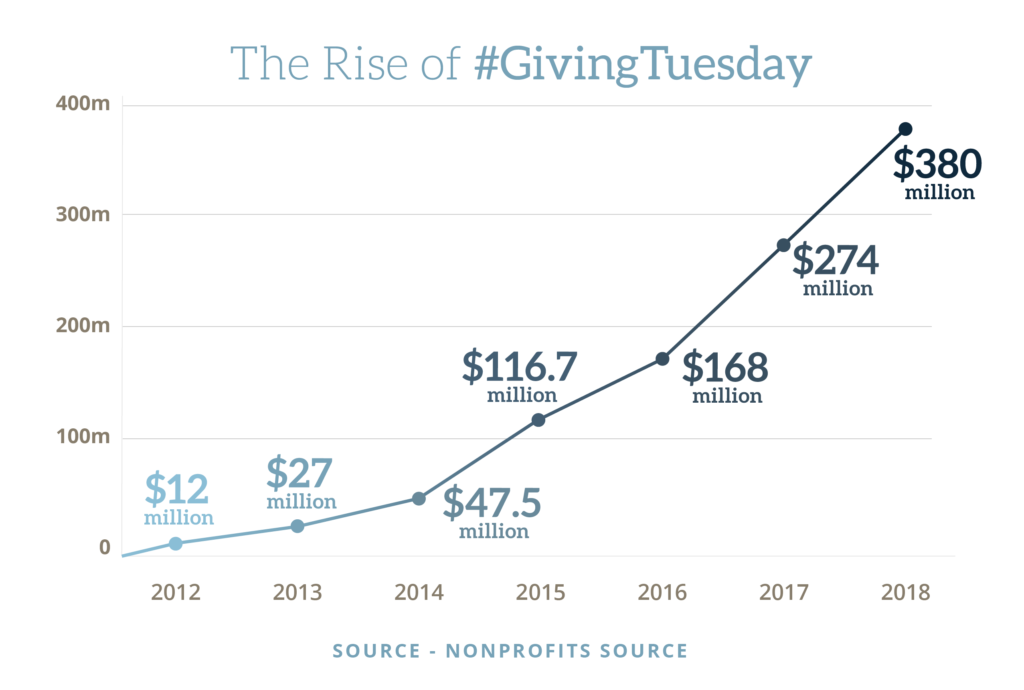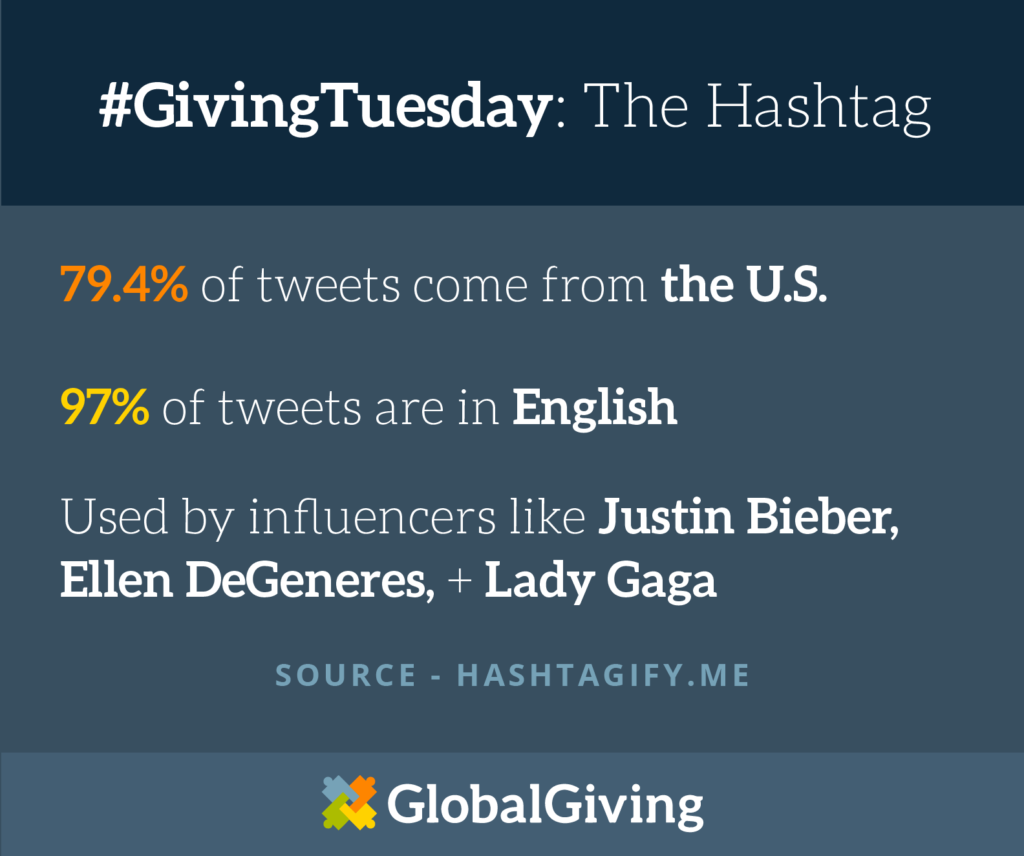Learn more about this fast-growing international philanthropic movement.
GivingTuesday occurs on the Tuesday after the US Thanksgiving holiday. It is a day to inspire generosity amongst billions of people around the world to support the causes they believe in and the communities they care about.
Every year since 2012, GivingTuesday has raised millions of dollars for charitable causes. Anyone, whether it is individuals, nonprofits, or companies big and small, from anywhere can give and be part of the biggest philanthropic movement in the world. The goal of the movement is to create a tsunami of generosity that lasts well beyond a day to create lasting change.
Getting involved with GivingTuesday is easy and depending on whether you’re an individual, nonprofit, or a business, there are different ways to get involved!
The GivingTuesday organization suggests four main methods of putting your support behind this worldwide movement:
Organizations can use your skills to improve their operations and to make a difference in the community. The best places to find volunteer opportunities near you are VolunteerMatch, All For Good, Idealist, and on the GivingTuesday website. When you donate time to an organization you’re growing your leadership skills and making important connections in the community.
Word-of-mouth is the most powerful recommendation tool in the world. When you socialize with friends, co-workers, and online, you can amplify the GivingTuesday movement. When you donate, take an #UNselfie to show the world your reason for donating. You can advocate for giving overall, or for a specific organization. For other ways to publicly support important causes, check out DoSomething.org and Change.org.
GivingTuesday monetary donations are on the rise and making a huge difference in communities around the world. Nonprofit donations are an impactful and meaningful way to spend money doing the holiday season. Look for worthy causes certified by GlobalGiving, or via give lists from the world’s top philanthropists. GlobalGiving and many other nonprofits offer special matching opportunities to donors on GivingTuesday.
For organizations looking to get involved, here’s how to start.
One of the most valuable aspects of GivingTuesday for nonprofits is the creation of a public platform for talking about and socially engaging in charitable causes. The event provides charities with the chance to host serious conversations within public discourse about how nonprofit causes are funded and the real-life needs in global communities.
Donors and businesses are given the opportunity to partner with these organizations and provide meaningful assistance. Rather than emphasize problems without solutions, GivingTuesday is a chance to show the community tangible steps they can take to create a difference around them.
Learn more about GivingTuesday, and how you can be a part of the movement!
GivingTuesday is always five days after Thanksgiving. Since Thanksgiving’s timing varies every year, the date in November or early December depending on the year. The global celebration starts at midnight local time and runs for the full 24 hours.
Getting involved with GivingTuesday presents an opportunity to contribute to great causes around the globe and motivate others to do the same.
Mark your calendars! GivingTuesday will be celebrated on:
GivingTuesday was started in response to the biggest shopping day of the year, Black Friday. At first, participation was largely within the US. Today, GivingTuesday is a popular movement with increasing local, national, and international momentum.
The New York 92nd Street Y and the United Nations Foundation began GivingTuesday in 2012. Henry Timms announced it via Mashable. Several major nonprofits helped raise awareness of this new day as founding partners, including Heifer International, Kiva, DonorsChoose.org, charity:water, and GlobalGiving.
Participation in the event was open to other nonprofit organizations. Nonprofits could hold their own branded fundraisers and special events using the GivingTuesday hashtag and promotional materials. The event was specifically designed for charities to put their own spin on GivingTuesday and to customize the marketing to activate their donorbase.
Thanks in large part to social media promotion, GivingTuesday quickly went viral and attracted thousands of nonprofits, billions of individuals and corporate donors.
Strategically placed right in the midst of one of the biggest shopping seasons, GivingTuesday serves as a reminder to include doing good as part of the holiday celebrations. Individuals and organizations can contribute on GivingTuesday, and collectively build a happier and healthier society.
GivingTuesday gets bigger every year, and the impact is growing. Donations primarily occur in the United States, but nonprofits in over 150 different countries have established GivingTuesday campaigns, according to the event’s organizers.
Even in places where Black Friday and Cyber Monday are entirely nonexistent, successful GivingTuesday campaigns are organized and launched, showing that the event can inspire and motivate public support even without the awareness these other shopping days. More than 14 billion social media mentions occurred last year, demonstrating significant public discussion and interest in talking about GivingTuesday.
Since it began in November 2012, GivingTuesday has grown as a movement. With each passing year, the event grows even bigger and attracts greater attention from donors and supporters.

During the first year, materials and promotional information were released shortly before the US Thanksgiving Day. The early promoters used word-of-mouth advertising to share information through their own nonprofit industry networks and increase momentum for celebrating the new day.
The timing for the new global day of giving turned out to be in-line with public interests and consistent with the fundraising efforts nonprofits were already planning to take on during end-of-year pledge drives. To some degree, public sentiment about over-commercialization of the holiday season provided a boost for GivingTuesday support. Many donors believed this new day would give much-needed recognition to charities just as US families were planning their gift-giving for the upcoming holidays. Organizers decided to plan another event the following year.
Donations for the 2012 season totaled $12 million from within the US and the event was largely considered to be a success. Ultimately, 2,500 nonprofit organizations participated and partners raised an average of $4,800.
For the second year, GivingTuesday organizers expanded participation to include global partners who were also looking for fundraising opportunities. The number of partners subsequently ballooned to 8,500 and the total amount donated increased to $27 million which was more than twice as much as the first year.
2013 GivingTuesday fundraising helped bring total US charity donations that year to almost 2% of the country’s total GDP, or $335.17 billion.
More than 20,000 organizational partners signed up for GivingTuesday in 2014 and raised $47.5 million through the event. A growing number of corporate partners signed up for campaigns including Fergie Footwear, who helped with the Dress for Success campaign and #GivingShoesDay.
That year, Blackbaud’s Charitable Giving Report showed that nonprofits receive about 18% of their yearly contributions during December, highlighting just how important the holidays and GivingTuesday are to nonprofits.
With 25 different donation platforms involved in 2015, GivingTuesday raised over $116 million for nonprofits, which was a 45% increase over the prior year. The average gift was $137 and the total contributions helped all US giving to nonprofits reach $358.4 billion that year.
In 2016, contributions grew another 44% and brought the year’s total to $168 million. At an average gift size of just $107, the typical gift was smaller than the previous year, but this may be because a larger number of donors were involved in GivingTuesday than ever before.
Growing to $210 million by 2017, GivingTuesday saw a total of 2.4 million online gifts and an average gift of $134.
Then in 2018, almost $400 million was raised online in the US which brought the total impact so far to over $1 billion since the first GivingTuesday event.
Since these totals are calculated based on online giving, it’s likely the true financial impact of the event is even greater globally. This big impact is due largely to increased recognition for the movement and efforts by activists and volunteers.
Corporate support has always represented a strong proportion of annual giving, but individual donations are also essential. Matching donations from companies such as PayPal, Facebook, and Microsoft have helped GivingTuesday grow every year. The average donation in 2018 was $105 with Facebook’s donation platform bringing in $125 million of the total raised last year from individual donors. This is 178% higher than the $80 million in contributions Facebook brought GivingTuesday nonprofits in 2017.
In 2020, GivingTuesday could be even bigger, thanks to word of mouth and nonprofit promotion.
Alongside promotional materials and plans to assist with participating in a GivingTuesday event, organizers created GivingTuesday to rally support on Twitter and other social media sites. The hashtag brings additional contributors and supporters, and helps increase recognition for the cause with every season it goes viral.

Since online donations are becoming an increasingly significant part of fundraising for many nonprofits, having a hashtag for the event is becoming an important way to promote giving.
According to Hashtagify.me, the Twitter hashtag #GivingTuesday is most frequently used within the US which represents around 80% of its total use. It’s also used in Europe, Asia, and South America (although these instances are less than 1%). The primary language used with the hashtag is English although 1% of hashtag uses accompany Spanish language posts.
Peak popularity tends to occur near the US holiday season since the event is closely related to Black Friday and Cyber Monday. Influential celebrity accounts have expressed support for GivingTuesday including Justin Bieber, Lady Gaga, and Ellen DeGeneres. Other variations of the hashtag are also used such as #GivingTuesday and #GIVINGTUESDAY.
For use this year, participants can share the #GivingTuesday hashtag for their own event promotion and outreach. Since the fundraising event operates as an independent movement, nonprofits who hope to benefit should plan their own campaigns and begin mobilizing supporters around the cause well in advance of this year’s date.
This year, GivingTuesday is Dec. 1 and marks the seventh annual celebration. Participation is open to everyone and the GivingTuesday website offers free resources and information. An optional registration allows nonprofit organizations to be listed on the GivingTuesday website, but donations aren’t collected for individual organizations through GivingTuesday. Charitable groups must create their own campaigns and websites for the event.
Since approximately 46% of donors still haven’t heard of GivingTuesday, there are a lot of potential supporters who are interested in donating to nonprofits but are unaware of the movement. Reaching these donors will likely require additional momentum and planning.
By making it easy to get involved, nonprofits and their supporters can strengthen the causes they care about and build momentum to push GivingTuesday 2020 forward.
Explore GlobalGiving’s GivingTuesday tips for nonprofits.
Featured Photo: Education Indigenous Women Leaders to Defeat Poverty by Diogo Heber for PSYDEHFind exactly what you're looking for in our Learn Library by searching for specific words or phrases related to the content you need.